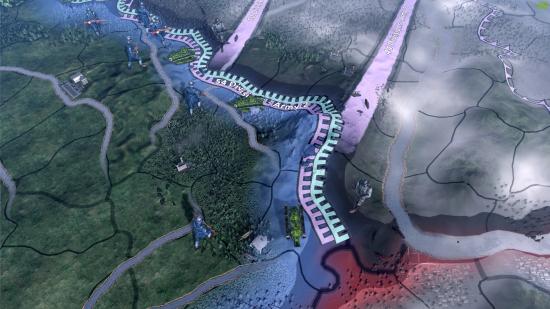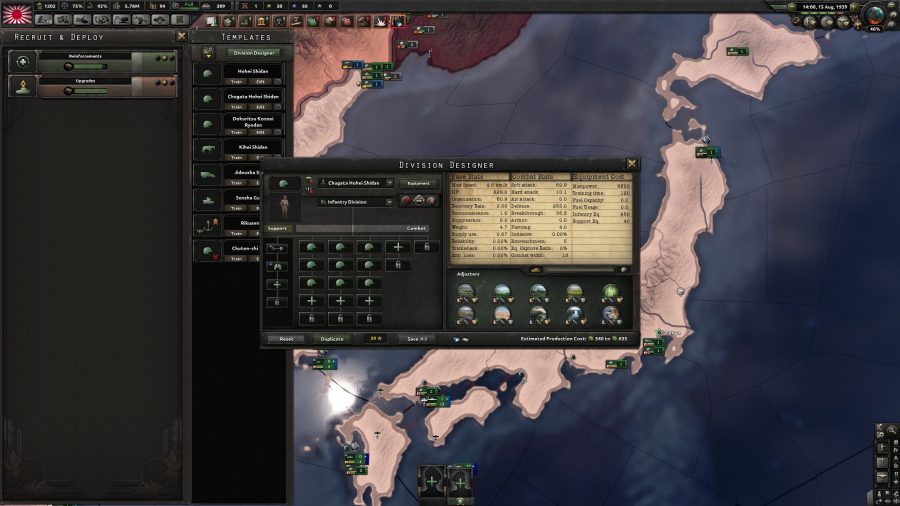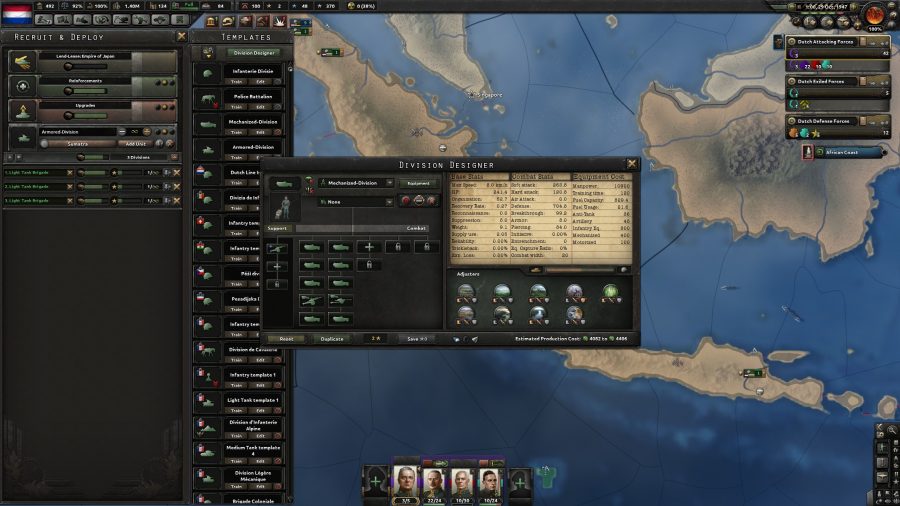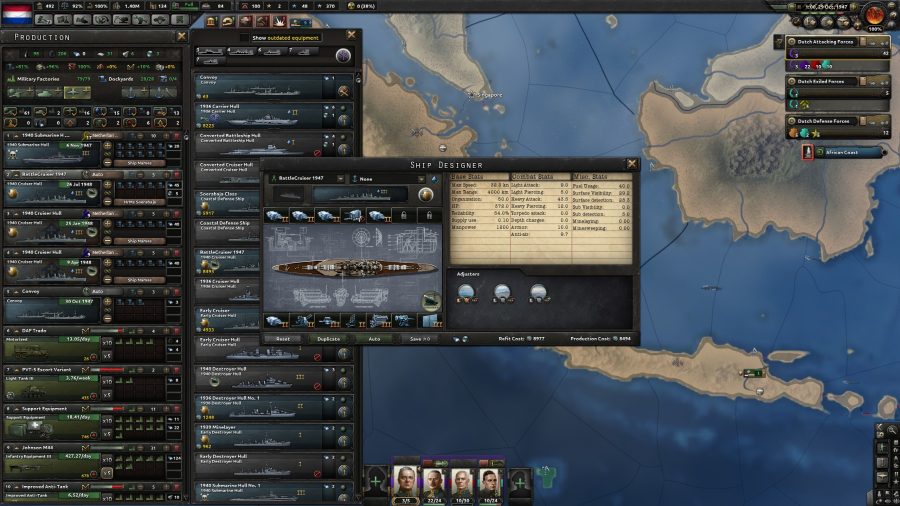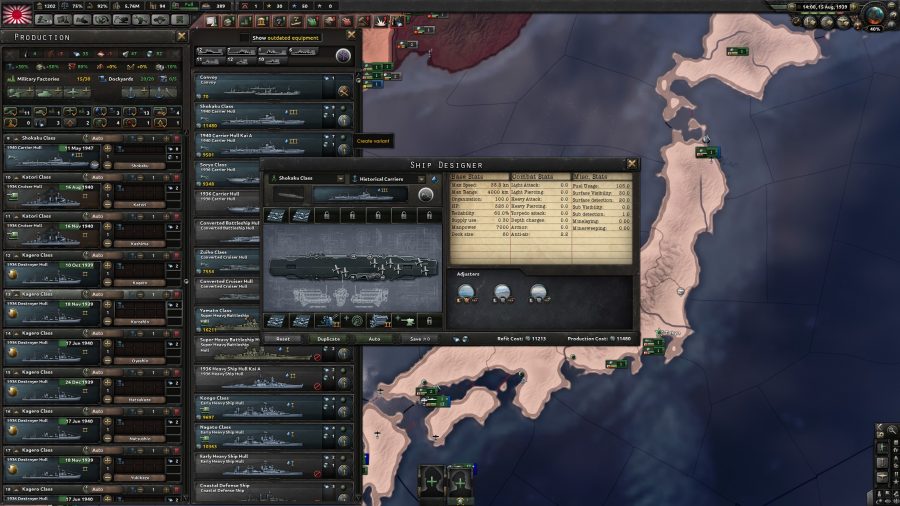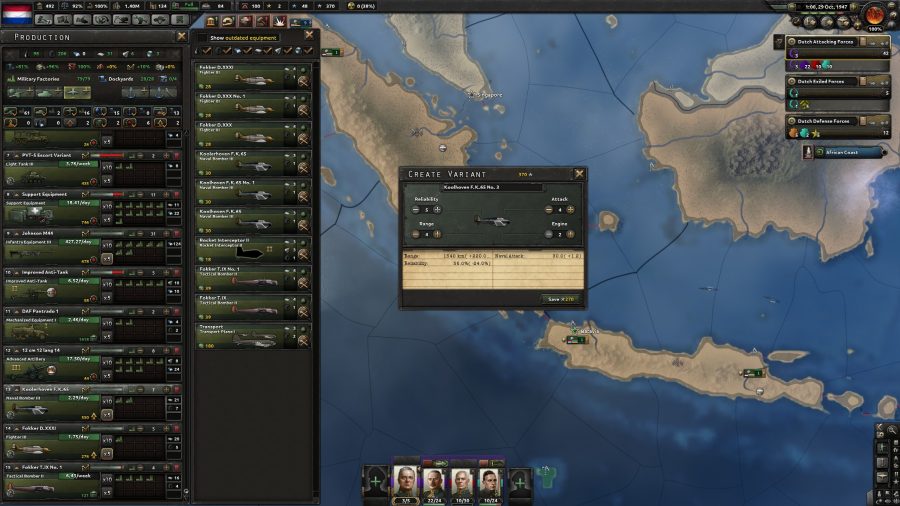Hearts of Iron 4 can be unapologetically brutal to new wargamers, due to the sheer number of systems involved – especially with numerous DLC and patches adding extra complexity to the already-sophisticated systems in the base game. And – as any hardened Hearts of Iron veteran will tell you – one of the most fundamental, crucial challenges to get your head around is optimising HoI4 division templates.
Luckily for you, that's where we come in! Now you have a handy guide to aid you in navigating the choppy organisational waters of the (second) war to end all wars. Make sure you're up to speed with all the latest changes as of the most recent patch.
Before going about weaving the grand strategies that will fuel your world-dominating/liberating campaign, it’s essential to master the cogs in your war-machine. The level of control you have over the makeup of individual divisions and ships can be daunting, but as long as you follow the rules laid out to you, you will be conquering away in no time.
We’ll cover each of your armed forces in turn, starting with the one which will likely take up most of your attention and play the starring role in most of your war plans: the good old-fashioned land army.
The Army
Arguably the most important part of an HOI4 military, most of the game’s combat mechanics revolve around divisions slugging it out with their evil counterparts on the opposing side.
COMBAT WIDTH
The main distinguishing feature between any two divisions is their makeup in the Division Designer. Here, you can add and subtract different types of battalions from a division, altering its combat stats and overall performance.
One of the most important considerations to take into account when designing a division is combat width.
Each division will take up an amount of space on the battlefield, and having more divisions on a side in a fight will lead to reduced effectiveness, or will block reinforcements from joining the fight altogether.
Most battlefields will have “combat width” of 80, meaning that optimal division sizes should be either 20 or 40, if you’re looking to min-max as much as possible (Note: if a province is attacked from multiple directions simultaneously, each new province will add 40 to the total allowed combat width, which means more units will be able to fight at once).
Generally, frontline battalions will have a width of 2, the most common exceptions being dedicated anti-air and anti-tank battalions. These both cost 1 width as they’re not considered ‘frontline’ fighters. Artillery is the other main outlier, costing a heavy 3 width.
SUPPORT COMPANIES
If you’re approaching your comfortable limit, consider adding a support artillery company rather than an artillery battalion. These ‘support’ companies don’t bring as much firepower as their larger counterparts, but they add nothing to the total combat width of a division.
On the subject of support companies, two that are almost necessary to include are the engineer company and the recon company.
The engineer company increases the amount a division can entrench itself, meaning that given enough time, a single division with an engineering team can become a major problem for an attacking force.
Want more company? Read our Hearts of Iron 4 DLC guide
Through research, the engineering team will also increase the general attack and defense of the division, particularly in rough terrain, i.e. urban environments, across rivers, forts, etc.
The recon company provides simpler benefits: speed and reconnaissance. A division with a recon team will move 10% faster across every terrain type, meaning they can reach the fight faster. This is incredibly important for any division that can expect to fight, but particularly so for divisions that use vehicles.
When your division does get into a fight, reconnaissance determines which tactic a side will pick in battle. The higher the reconnaissance value one side has in the fight, the higher the chance their general will pick a favorable or countering pick to the opposing force’s choice.
HOW TO BUILD DIVISIONS
There are other considerations to take into account when forming a division, such as what your enemies’ divisions look like, and where you will be fighting them.
For example, a division meant to fight tanks in European plains is going to suffer heavily if fighting infantry in African jungles. As such, here are some general tips to keep in mind when building divisions:
- The more battalions a division has, the more supplies it will need, so “heavier” divisions will frequently suffer attrition in bad terrain. Try using smaller divisions, or adding logistics companies to reduce the negative effects of the environment.
- All divisions that use trucks, half-tracks, or tanks should invest in a maintenance company. These companies will increase the reliability of the vehicles, meaning less are lost to attrition, and they will also capture a percentage of enemy equipment for you to use.
- Anti-air companies/ battalions increase your air superiority in a province, but they will only target close air support aircraft, not aircraft with strategic bombing missions (presumably, they fly too high for the anti-air guns to shoot them down).
- Standard “leg infantry” divisions are the most reliable and cost effective divisions you could hope for. You can build an infantry division to 20 width, add the necessary support companies, and then copy the template so you can alter it to fit your specific needs. Most of your divisions should be infantry divisions.
- Motorized divisions are faster than mechanized divisions until the third halftrack becomes available, keep this in mind when looking for speed.
- A division only travels as fast as its slowest part, so it may be wise to pair up a single super heavy tank battalion with an infantry division, as they move at the same speed.
- A single anti-tank company with the most up-to-date guns can allow most divisions to pierce enemy armor.
- Infantry has naturally higher organization than tank battalions and support gun battalions. As such, for campaigns that see units being in repeated battles, divisions with a higher ratio of infantry will be able to stay in the front lines longer.
For more information on divisions, I recommend checking out the Hearts of Iron 4 wiki page on the Division Designer & land combat stats.
The Navy
The naval mechanics had a major overhaul thanks to the Man the Guns expansion, so don’t feel alone if you haven’t played in a while and are confused about what’s new.
Ships used to have a similar improvement structure to armored land vehicles and aircraft (which we’ll cover after this section) where a specific ship would be researched, then could be improved by spending experience points. Now hull types rather than whole ships can be researched, as well as the individual modules for ships.
Every ship has an amount of slots that can be filled by these modules, but the catch is that ships will take longer to be built with advanced modules and higher amounts of modules overall.
There are also restrictions on what ship types can equip certain modules. It doesn’t make much sense to put an aircraft hangar on a submarine, even though you really want to!
There are 5 main types of ship hulls: destroyer, cruiser, heavy, carrier, and submarine. There is a 6th hull type, the super heavy hull, but that only exists as an alteration of the 1936 heavy ship.
These ships can vary widely in their roles based on what modules are placed on them, so we’ll go into a breakdown of the general capabilities of specific hull types.
DESTROYERS
These are light and fast ships that are some of the quickest to produce. They can be outfitted with some modest main guns, but the 2 main uses of destroyers are as torpedo boats and submarine hunters.
Due to their speed, a large amount of destroyers can swarm enemy heavy ships and deal heavy damage with torpedoes. These fleets are relatively easy to build due to the short build time of destroyers, and everything but torpedoes can be stripped off the ship to make the build time even quicker, though this will render them ineffective in any other situation.
Destroyed it already? Try our list of the best Hearts of Iron 4 mods
Destroyers can also be outfitted with sonar and depth charges, which is the one way surface vessels can attack submarines. Curiously, due to naval battle AI, submarines will flee almost any battle with depth charge-equipped destroyers, being that the destroyers can actually hurt them.
This means that as of the current patch (1.6.2), destroyers may actually function better as convoy raiders than submarines, because destroyers will not automatically flee the second a small enemy force appears (Note: thanks to Rimmy for pointing this out in his HOI4 video!). This will hopefully not be true forever, but keep this in mind for the near future.
CRUISERS
This is the most versatile of the hull types, with the ability to fill almost any role needed. Cruisers can be outfitted with heavy guns and armor, classifying them as heavy cruisers that can perform reasonably well as capital ships.
Alternatively, they can have lighter guns mounted with a stronger engine, and they can pursue marauding destroyer packs, or they can have several anti-air batteries bolted to the deck as a means of creating a floating “no-fly zone.” But even though cruisers can cover many different bases, they don’t excel as much as the ship types that are meant to perform in those roles.
Cruisers take longer to build than destroyers and aren’t quite as fast, and the heaviest cruiser will most likely lose a prolonged engagement with an enemy battleship. Even so, they can be a multi-tool for any situation, and can be refitted to change their role in the seas.
HEAVY SHIPS
These are the undisputed kings of the sea in the first several years of the game. They have access to the thickest armor and the largest guns out of all ship types, but they are generally slower than other ships, and take longer to build as well.
The big guns on battleships are excellent at killing cruisers and other capital ships, but they are less accurate against destroyers. Battleships can trade some of their extra module space for smaller guns specifically meant to target lesser ships, but this lessens the effectiveness of the battleship in its primary role, which is to fight the enemy’s capital ships.
Take the conn: Read our list of the very best naval games
Battleships also take a very long time to build compared to smaller ships, meaning that ships you begin construction on will likely be equipped with subpar tech by the time they launch. However, an old battleship is still a battleship, and can be very useful when working with a capable fleet.
CARRIERS
These are very straightforward as far as ships go: their sole purpose is to launch aircraft that will assist in combat. Aircraft are very effective against enemy fleets in large numbers, but a fleet with solid anti-air cover can severely inhibit a carrier’s ability to do its job.
Outside of fighting specific anti-carrier fleets, carriers are arguably the strongest ship type in the game for the ability to project air power not only in battle, but in the sea region the carrier is operating in, or even the neighboring land province.
Much like battleships, carriers do take a long time to build, but battleships and some cruisers can make up for this time by performing carrier conversions that slap a flight deck onto these ships after removing the guns. They do not have the same aircraft capacity full carriers do, but they can be sufficient as support carriers.
Carriers are vitally important to fleets in HoI4: if you don’t want to build any of your own, you should still plan to specifically target and kill enemy carriers. As of the most recent patch, fleets with the Carrier Air advantage impose positioning penalties on the opposing fleet as well.
SUBMARINES
Speaking of killing enemy carriers, Submarines excel at hunting down enemy capital ships and shipping.
Deep impact: Submarine fans should try our Silent Victory review
They are also very, very cheap compared to other ships, so a fleet of submarines can quickly be assembled to threaten unprotected enemy ships.
NAVY BUILDING TIPS
- Submarines, destroyers, light cruisers, and eventually bombers can lay mines in naval regions if they have minelaying modules. It may be beneficial to build cheap ships that just have minelaying / minesweeping capabilities so you can quickly build up defenses or clear them out as the need arises.
- Don’t be afraid to launch a ship then immediately send it to be refit with newer technology, the benefit of the newer tech can be worth the wait.
- Air superiority will impact the effectiveness of naval missions, so provide air cover for your fleets when possible.
- Build your fleet to counter the enemy fleet. If the enemy is focusing on building mainly capital ships, invest in torpedo technology. If the enemy likes swarms of smaller ships, build ships with many light guns that are more effective against those ships.
- Research engines early, being faster than the enemy fleet will give your ships a huge advantage.
- The bigger the ship, the more fuel it consumes. Ships with more advanced engines will use more fuel, so keep that in mind when your fuel is running dry.
The Air Force
The air power part of the combat trifecta is undoubtedly the most abstract, and has less moving parts than either of the other two dimensions. However, it is airpower that can be the determining factor in land or sea battles, so it is important to detail. Aircraft are split into 2 main trees, which I’ll refer to as the “light” and “heavy” trees.
LIGHT AIRCRAFT
The “light” tree has close air supports (CAS), fighters, and naval bombers. These aircraft are generally more agile and faster than the aircraft in the other tree, but have less heavy armaments and have shorter ranges than the heavy aircraft.
Bird’s eye view: Read our Command: Modern Operations review
These aircraft also have carrier variants that are generally slightly slower than their land-based counterparts, along with further reduced range. Light aircraft are meant to be deployed at the tactical level, or attached to an army so they follow them along the front as support.
HEAVY AIRCRAFT
The “heavy” aircraft consist of the heavy fighter, the tactical bomber, and the strategic bomber. These aircrafts have longer range and stronger armaments than the “light” aircraft, but consume more manpower, and are not as good at targeting specific units. “Heavy” aircraft, due to their range and their intended targets are generally better at the strategic level.
All aircraft can have variants that be upgraded in 4 categories: reliability, range, attack, and engine. Generally, when creating a variant of an aircraft, it is beneficial to upgrade the category that the aircraft already is dominant in, in order to double down those strengths.
For example, a fighter’s strength comes from its high agility, which both helps them to attempt attacks on enemy aircraft and avoid attacks from the enemy. Upgrading the agility of fighters would give them even more of an advantage over the enemy.
However, the other categories do not need to be neglected for the “preferred” category, but every point sunk into an upgrade makes the next one more costly in experience points, so spend carefully!
AIR COMPOSITION TIPS
- Heavy fighters perform better in larger provinces due to their increased range, while regular fighters perform better in smaller regions.
- Upgrading reliability on aircraft is always a smart move as this will decrease the amount of aircraft lost to accidents.
- The strategic bomber is relatively expensive compared to the tactical bomber. It may be wise to build more of the less effective tactical bombers for strategic bombing in order to have enough aircraft bombing the enemy’s factories.
- Heavy fighters are more expensive than regular fighters, but heavy fighters count more towards air supremacy for your side. Consider investing in a more agile heavy fighter to make more use of this effect.
- If you have multiple air bases in an air region, investing in longer-ranged aircraft is less important, because you can simply re-base your shorter-ranged aircraft to where you need them.
